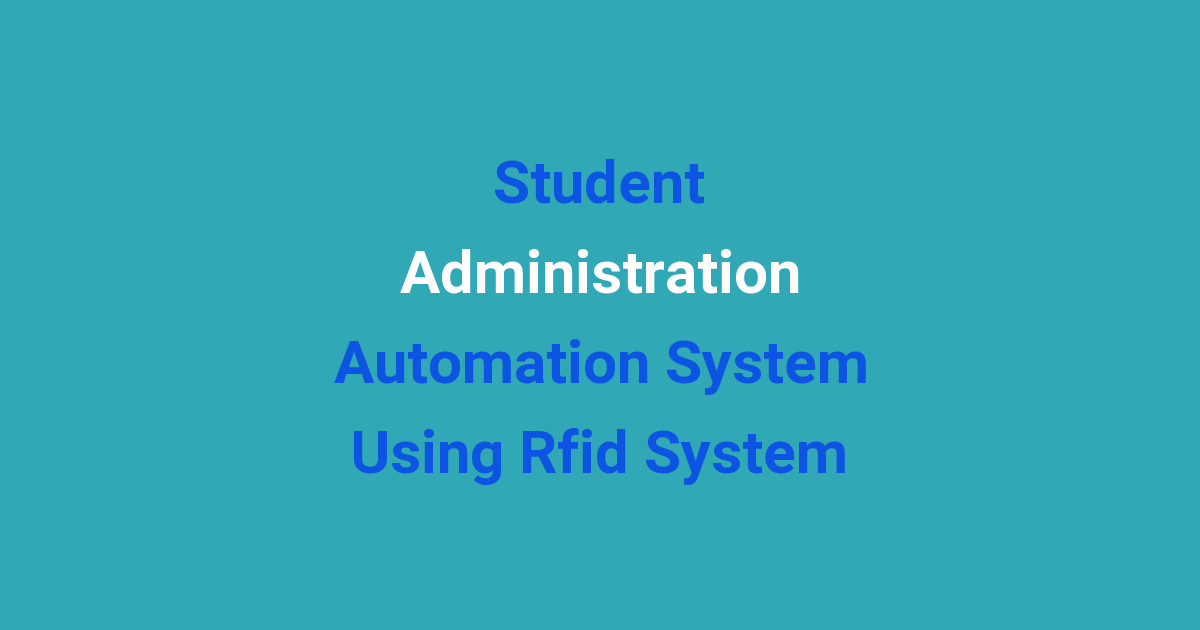RFID system integrated student administration automation system.
Student Administration Automation System Using RFID System
Introduction
In today’s fast-paced world, it is essential for educational institutions to adapt to new technologies to streamline their administrative processes. One such technology that has gained popularity in recent years is Radio Frequency Identification (RFID). RFID systems use electromagnetic fields to automatically identify and track tags attached to objects. In the context of student administration, an RFID system can be used to efficiently manage student records, attendance, and access control. This project aims to design and implement a student administration automation system using RFID technology to improve the overall efficiency and security of academic institutions.
Problem Statement
Traditional methods of managing student records and attendance are time-consuming and prone to errors. Manual processes such as paper-based registration and attendance tracking can lead to inefficiencies and inaccuracies. Additionally, the security of sensitive student information can be compromised if not adequately protected. The existing system lacks automation and integration, leading to delays in administrative tasks and creating a cumbersome experience for students, faculty, and staff.
Existing System
The current student administration system in most educational institutions relies heavily on manual data entry and paper-based processes. Student records are stored in physical files and attendance is recorded manually by teachers. This manual approach is not only labor-intensive but also increases the risk of errors. Moreover, security measures such as ID cards and passwords are not foolproof and can be easily tampered with or misplaced. Overall, the existing system is inefficient, unreliable, and lacks the required level of automation to meet the demands of modern academia.
Disadvantages
Some disadvantages of the existing system include:
1. Inefficient data management: Manual data entry and storage result in delays and errors in updating student records.
2. Inaccurate attendance tracking: Manual attendance recording can lead to discrepancies and inaccuracies in tracking student attendance.
3. Security vulnerabilities: ID cards and passwords can be lost, stolen, or misused, compromising the security of student information.
4. Lack of automation: The absence of automated processes hinders the efficiency and effectiveness of administrative tasks.
5. Limited integration: The existing system is not integrated, leading to data silos and inefficient communication between departments.
Proposed System
The proposed student administration automation system will leverage RFID technology to automate student record management, attendance tracking, and access control. Each student will be assigned a unique RFID tag that will store pertinent information such as student ID, attendance records, and access permissions. RFID readers strategically placed around the campus will capture this information in real-time, enabling administrators to manage student data efficiently and accurately. Additionally, biometric authentication will be implemented to enhance security measures and ensure that only authorized individuals have access to sensitive information.
Advantages
Some advantages of the proposed system include:
1. Efficient data management: Automated data capture and storage will streamline administrative processes and reduce errors in managing student records.
2. Accurate attendance tracking: Real-time attendance tracking through RFID technology will ensure accurate monitoring of student attendance.
3. Enhanced security: Biometric authentication and RFID tags will enhance the security of student information and access control.
4. Increased automation: The system will automate routine administrative tasks, freeing up time for staff to focus on more critical responsibilities.
5. Improved integration: The proposed system will facilitate seamless communication and data sharing between different departments, improving overall efficiency and collaboration.
Features
The student administration automation system using RFID technology will include the following features:
1. RFID tags for students: Each student will be assigned a unique RFID tag containing their student ID and other relevant information.
2. RFID readers: Readers placed at various locations on campus will capture student data in real-time.
3. Attendance tracking: The system will automatically record student attendance based on RFID tag scans.
4. Access control: RFID tags and biometric authentication will control access to campus facilities and sensitive information.
5. Centralized database: All student information will be stored in a centralized database accessible to authorized personnel.
6. Reporting and analytics: The system will generate reports and analytics on student attendance, performance, and behavior.
Conclusion
In conclusion, the implementation of a student administration automation system using RFID technology offers numerous benefits in terms of efficiency, accuracy, security, and integration. By leveraging RFID tags and readers, educational institutions can streamline their administrative processes, enhance student experience, and improve overall operational effectiveness. The proposed system addresses the limitations of the existing manual system and provides a comprehensive solution for modern educational institutions looking to embrace digital transformation. With its advanced features and capabilities, the RFID-based student administration system is poised to revolutionize the way academic institutions manage student data and administrative tasks.

